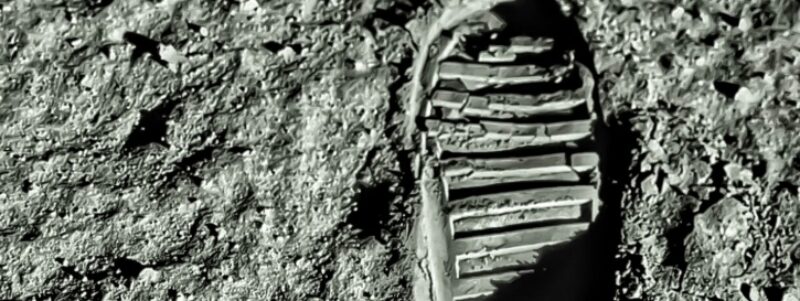On 20 July 1969, Neil Armstrong delivered his immortal line “That’s one small step for man… One giant leap for mankind”. He did so as he emerged from the Eagle lunar module to become the first human being to set foot on the surface of the moon.
Our species’ obsession with the moon stretches back to Galileo’s 1610 sketches and beyond, to ancient stories about the mythical “Man in the Moon”.
There have been plenty of books on the subject too. As we celebrate the anniversary of one of humankind’s greatest-ever achievements, here are five fascinating looks at man’s foray into space to add to your to-read pile now.
1. Moondust by Andrew Smith
Moondust: In Search of the Men Who Fell to Earth is the fascinating story of the human beings that have walked on the moon.
When Apollo 12 astronaut and the third person to step on the moon’s surface, Pete Conrad, died in 1999, journalist Andrew Smith received the news from an unlikely source.
That afternoon, Smith was interviewing fellow US astronaut and “moonwalker”, Charlie Duke. A crew member on the Apollo 16 mission, Duke is the youngest person to ever walk on the moon and the 10th out of just 12 (so far).
On hearing the news, Duke told Smith, “Now there’s only nine of us.”
This comment became the seed for Moondust, as Smith set out to interview all surviving moonwalkers.
The book compiles the firsthand stories behind the missions, providing an insight into what it feels like to look back at Carl Sagan’s “Pale Blue Dot” from the emptiness of space, and the difficulties of returning to an earthbound life.
2. The Right Stuff by Tom Wolfe
Tom Wolfe’s The Right Stuff (1979) tells the pre-Apollo story of America’s efforts to put men into space.
The story begins with the dangerous – and often short – lives of the US’s original test pilots and the more high-powered rockets that followed. It was in the latter that Chuck Yeager would become the first pilot to break the sound barrier.
Next comes Project Mercury and the intense selection process that saw Pete Conrad and Jim Lovell (of Apollo 13 fame) originally miss out.
The highs and lows, the jealousy and internal fighting, and the thrill (and occasional boredom) of life in space are all here.
By focusing on Project Mercury, rather than the Apollo missions, Wolfe provides much-needed background to the space race, the US’s desire to put men on the moon, and what it took to make that journey.
3. Carrying the Fire: An Astronaut’s Journeys by Michael Collins
In July 1969, Neil Armstrong became the first person to walk on the moon. Buzz Aldrin joined him 19 minutes later.
With the Lunar Module, the Eagle, on the surface, it was left to Michael Collins to pilot the command module Columbia in orbit around the moon.
In his awe-inspiring memoir, Carrying the Fire, Michael Collins tells his own story. From military test pilot to Project Gemini astronaut (the missions which followed Mercury), Collins’ story leads inevitably to Apollo 11.
A captivating story of space and the race to the moon, Collins’ tale is packed with personal anecdotes from the mission, capturing the drama and beauty of the moon-landing mission and his hours alone, on the far side of our closest celestial body.
4. Seize the Moment: The Autobiography of Britain’s First Astronaut by Helen Sharman
Tim Peake’s time on the International Space Station captured the public’s imagination in 2016. It also spawned some incredible books, including his autobiography, Limitless (2020), and 2024’s Space: The Human Story.
But Peake wasn’t the first British astronaut. Helen Sharman accomplished that incredible feat back in 1991 when she spent eight days visiting the Mir Space Station.
In Seize the Moment: The Autobiography of Britain’s First Astronaut, Sharman tells her own story. From witnessing the moon landing as a child to signing up for Project Juno, the book covers her journey to the stars.
Not least, the intense selection process that saw her win out over 13,000 applicants based on factors including her scientific knowledge, education, and aerospace background.
5. Challenger: A True Story of Heroism and Disaster on the Edge of Space by Adam Higginbotham
Testament to the enduring power of space exploration to enthral and horrify us, Higginbotham released Challenger, just last month (June 2024).
It tells the tragic story of the build-up to Challenger’s failed launch in 1986. The shuttle exploded 73 seconds after take-off, killing all seven astronauts in an event that shook the world.
Packed with technical detail and a driving plot, Higginbotham’s research uncovers a story of underfunding and corner-cutting, red tape, and bureaucracy. And ultimately a tragedy that could so easily have been avoided.
It’s a reminder of the bravery of all of those that have gone before, and the danger inherent in humankind’s continued exploration of the moon and the infinity of space beyond.

